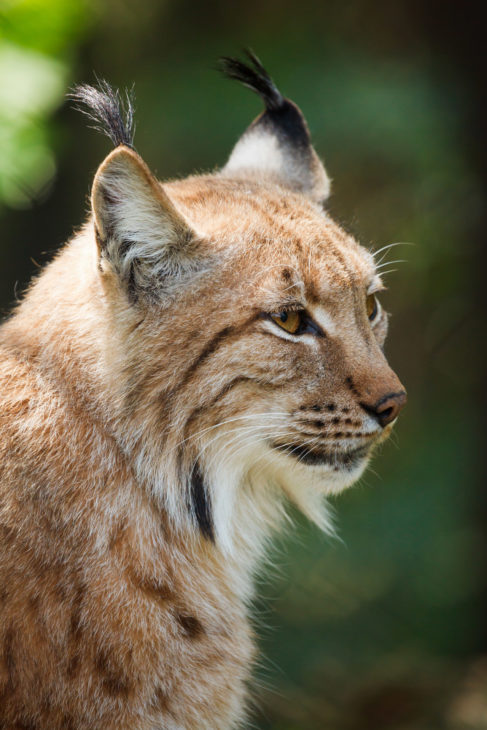Could we reintroduce lynx to Scotland?
The Trust believes that there is a case to be developed that would support the reintroduction of lynx. In this article, Tom Ovenden, who previously worked for the Trust as the Handa Ranger for two seasons, discusses the findings of his recent research on how lynx might spread if reintroduced to Scotland.
Next generation tools for effective reintroduction decision making
Lynx reintroduction to Scotland, like so many issues relating to large carnivores world-wide, is embroiled in controversy. Resolving this is greatly hindered by a lack of clear evidence that can be used to make effective, informed decisions about the appropriateness of any reintroduction proposals.
Our work, published in the journal Biological Conservation, uses cutting-edge modelling tools to bring clarity and robust evidence to one key aspect of this debate in Scotland: is there enough suitable habitat to enable any reintroduction to be a success and, if so, where should we focus our efforts?

Reintroducing large carnivores is complex, costly and challenging, not least because of the animal welfare implications, socio-economic considerations and ecological uncertainties. Collectively, this means that getting things right first time is essential. In turn, this makes advances in computer modelling that accurately reflect developments in ecological theory, whilst accounting for the specific characteristics of a particular species in complex landscapes, really valuable. Such a modelling approach provides a safe and inexpensive space to test the effectiveness of any proposals, before proposing their implementation on the ground.
Our research used such a model to contribute reliable evidence to the current debate surrounding the reintroduction of the Eurasian lynx to Scotland and, more broadly, used this as a case study to demonstrate how our approach could be used for reintroductions and conservation management of other species.
The arguments for a lynx reintroduction are numerous, from calls to restore an ecological balance, using lynx to help control spiralling deer numbers, through to economic and tourism potential. These arguments, however, face considerable opposition, with concerns raised from landowners and other stakeholders as to the long term, broader impact of such a reintroduction, in addition to the current suitability of our heavily modified rural landscapes to accommodate this species.
For policy makers and practitioners to address satisfactorily the arguments for and against a lynx reintroduction, we need good quality evidence. The IUCN has very clear guidelines when considering if a reintroduction is suitable. Ranked highly amongst these considerations is to establish with confidence that the historic causes of extinction are no longer present and pose no threat to future populations. It is essential then, that prey availability, persecution risk and restricted habitat availability are no longer limiting factors in establishing a healthy, viable population of lynx.
It would be hard to argue that the abundance of their favoured prey species, roe deer, across Scotland would be a limitation. However, the risk of persecution is linked to the public appetite for a lynx reintroduction, and knowledge of the current location, extent and connectivity of suitable forest habitat is essential. Until recently these were relatively unknown quantities, but our research now sheds much needed light on the last of these points.
Having generated high resolution maps of different habitats across Scotland, with a particular focus on woodland areas suitable for lynx, we gathered detailed information on all aspects of Eurasian lynx ecology from published literature and other studies. We then put this information and our maps of Scotland into a recently developed, sophisticated individual-based model called “RangeShifter”, designed to capture realistic movement patterns across complex landscapes. Once all these pieces were in place, we were able to run 100-year simulations to test which areas of Scotland that were previously identified as potential release sites might be most suitable for a reintroduction – from the perspective of habitat availability.
Whilst our work does not investigate the political will or polarised public appetite for a lynx reintroduction … it does offer an encouraging step forward
The three locations we considered were Aberdeenshire, the Scottish component of Kielder Forest and the Kintyre Peninsula. Regardless of how we chose to measure success, and irrespective of several changes we made to the model parameters we used (for example how many kittens the lynx would have or how long they would live), the Kintyre Peninsula always came out on top, offering up to an 83% chance that 100 years after a release, a good population of lynx would still be around. Kielder Forest was always the least suitable location for a lynx reintroduction from those we tested, with only a 21% chance a population would still exist after 100 years.
Crucially, we also demonstrated how the Highlands of Scotland, the region in which the majority of suitable habitat exists, is functionally isolated from habitat in the Southern Uplands, south of the Glasgow-Edinburgh “Central Belt”. Very few lynx ever successfully crossed this Central Belt region in any of our simulations.
Whilst our work does not investigate the political will or polarised public appetite for a lynx reintroduction (both of which are essential additional components of any reintroduction plan), it does offer an encouraging step forward, demonstrating the suitability of Scotland’s landscape to support a reintroduction. This suitability is, however, clearly location-dependant. The novel application of this model to reintroduction planning holds great promise, not just for informing the debate of lynx reintroduction to Scotland, but also for the conservation of species globally.
by Tom Ovenden
Further reading
Help protect Scotland’s wildlife
Our work to save Scotland’s wildlife is made possible thanks to the generosity of our members and supporters.
Join today from just £3 a month to help protect the species you love.
Preface
The Trust believes that there is a case to be developed that would support the reintroduction of lynx. In this article, Tom Ovenden, who previously worked for the Trust as …
